How to Dehydrate Onions for Food Storage
This post may contain affiliate links, which means that I may receive a commission if you make a purchase using these links. As an Amazon Associate I earn from qualifying purchases.
Are your onions getting soft? It is easy to dehydrate onions so they last longer for food storage. Turn your onions into dehydrated onion flakes, minced dried onions, and onion powder.
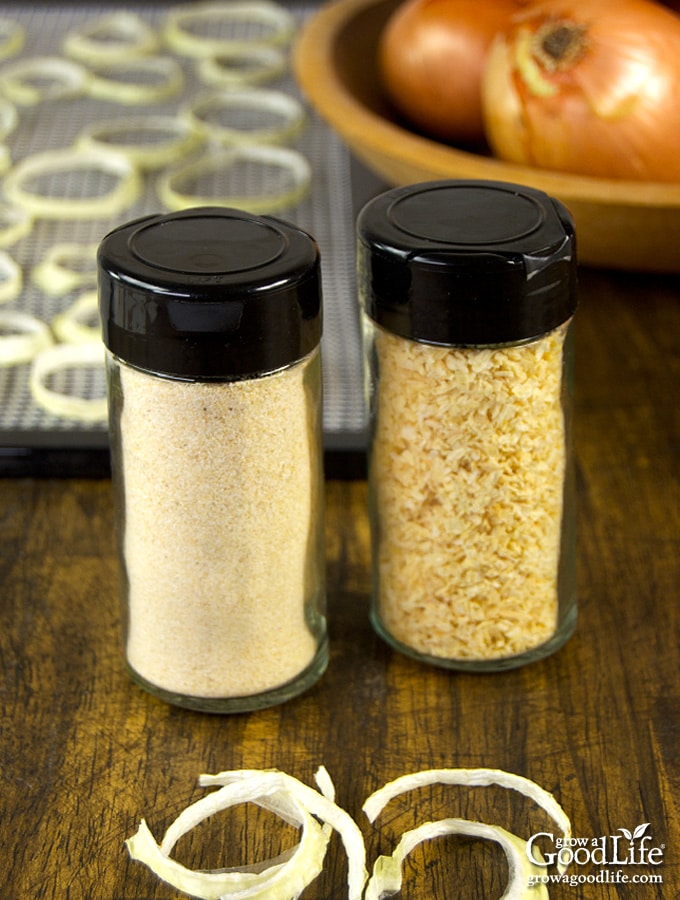
I grow a lot of storage onions that keep in my cool basement for winter. Sometimes, we don’t use them up before they begin to get soft. The good news is onions can last even longer by turning them into dehydrated onions before they spoil.
Ways to Use Dehydrated Onions
Substituting dried onions is the perfect shortcut in the kitchen if you don’t have time for peeling and chopping onions. Here are some ways you can use dried onion flakes, dried minced onions, and onion powder in everyday cooking:
Add dried onions directly to foods: Add dried onion flakes and minced onions directly to simmering soups and stews. They will reconstitute with the liquid and add onion flavor.
Use onion powder in dry herb mixes: Powdered onion dissolves and combines easily to provide flavor. Onion powder also combines easily with dried herbs and spices to make a shelf-stable mix, such as DIY herb blends, taco seasoning, and rub mixes.
Rehydrate dried onions: Dehydrated minced onions can be reconstituted and used like chopped onions in raw and cooked foods. To rehydrate onions, soak one part dried minced onions in two parts warm water until soft, about 20 minutes. Then proceed with your recipe.
Tips for Dehydrating Onions
Dehydrating food is a great way to preserve your garden harvest. The process of drying fruits and vegetables removes moisture so the food doesn’t spoil when stored at room temperature. Dried food takes up less space in storage and can be easily reconstituted without losing flavor. Here are some tips for dehydrating onions:
Use a food dehydrator
A food dehydrator is an essential kitchen tool that makes preserving easy. It dries food by blowing warm air through drying screens. For small batch drying, this stackable food dehydrator will serve you well. For larger-scale food dehydrating, consider one of the Excalibur dehydrators.
Dehydrate onions outside
The smell of drying onions is very strong and will linger in your home for a long time. Instead of smelling up your house, place your dehydrator outside on your porch, or in a shed or garage with the door open.
Additionally, the smell of onions will linger on your dehydrator trays. To remove the odor from your dehydrator trays, wash well in warm, soapy water and rub with lemon juice. Rinse and air dry. Give it a sniff test, and repeat if necessary.
Cut the onions evenly for drying
Similar sized pieces will dry at the same rate. Slice your onions into even pieces before layering on the dehydrator trays.
If you are handling a large amount of onions, consider using the slicer blade on your food processor to slice the onions. Simply cut them into wedges to fit the feeder tube, and process the onions through the slicing blade.
Slice onions without crying
Cutting onions breaks open microscopic cells of enzymes that turn into volatile gasses as they escape. Your eyes produce tears in order to dilute and flush the substance away from your eyes. Here are tips to cutting onions without crying:
- Use eye protection: Wear kitchen goggles to protect your eyes from the gas.
- Chill the onions: Refrigerate the onions before cutting to minimize the amount of gas released into the air.
- Use a sharp knife: Cutting onions with a sharp knife will release fewer enzymes into the air.
- Cut the root last: The root end of the onion has a higher concentration of enzymes.
- Let kitchen tools do the work: Use a food processor to slice the onions quickly.
If your eyes are irritated after slicing onions, flush them with cool water and use eye drops. Be sure avoid touching your eyes and wash your hands well.
Check the jars of dried onions for moisture
After drying and storing your onions in clean jars, check the jars in a few days after to be sure there is no moisture accumulating on the glass. Moisture in the jars is a sign that your onions were not dried entirely before packing.
If the onions are not completely dry, they will get moldy. If you discover moisture in your jars, use the dehydrator to dry the onions further, cool, and repackage in clean, dry jars.
Helpful equipment for dehydrating onions:
- Food dehydrator
- Knife
- Cutting board
- Spice grinder
- Mesh strainer to separate onion flakes from onion powder
- Spice jars
- Gloves (optional to protect your hands from the strong onion fragrance)
- Kitchen goggles (optional to shield your eyes)
Steps for Making Dehydrated Onions
Any onion can be dehydrated, including red, white, and yellow. If you are cutting by hand, you may wish to wear gloves and eye protection to shield yourself from the pungent onion fragrance.
Step 1: Prepare your onions
Remove the onion skins, trim the ends, and slice into even sized pieces. I like to cut the onions in half, and then slice each half into 1/4-inch pieces. Sometimes, I use my food processor’s slicing blade to speed up the process.
The onions can be in any shape, as long as they are all about the same size, so they will dry evenly. You can cut the onions into rings, chunks, or whatever is easiest. Just try to keep the pieces large enough so they don’t fall through the screens of your dehydrator.
- Tip: Save the onion trimmings in the freezer for homemade chicken stock.
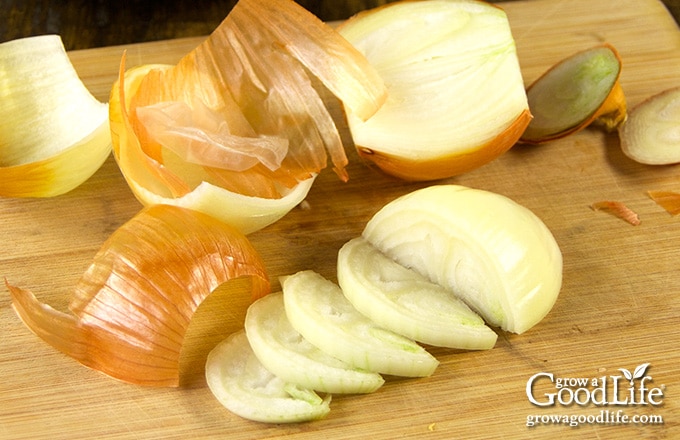
Step 2: Spread the onions out on the dehydrating screens
Separate the onion segments and spread them out evenly on your dehydrator tray. The onion pieces can touch, but try not to overlap them, or they may not dehydrate evenly.
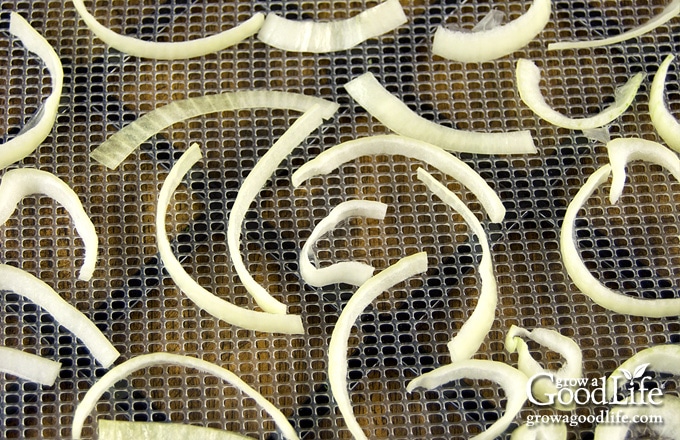
Step 3: Dry your onions
Dehydrate at 125˚F until completely dry, about 3 to 9 hours depending upon the size of your pieces and moisture content of your onions. It’s ok to stop the dehydrator and start it up again the next day. Follow the instructions for your dehydrator.
Rotate your trays so the onions dry evenly. The dehydrated onions should be crisp and snap when your break them.
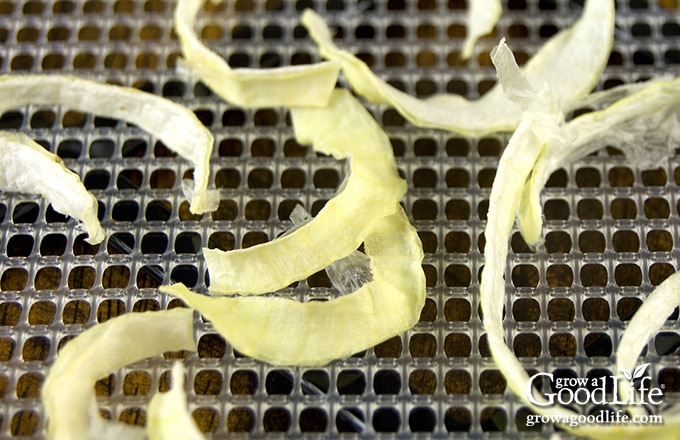
Step 4: Package and store your dried onions
Let the onions cool after dehydrating, crush them into onion flakes with your hands or a mallet, and then package into airtight glass containers.
Label, date, and store the jars of dried onion flakes in a dark, cool area. Check the jars in a few days to be sure there isn’t any moisture accumulating on the glass.
I fill small jars for my spice cabinet, and then store the rest of the dehydrated onions in mason jars in my basement food storage area. Properly dehydrated onions will not spoil, but the flavor does diminish over time.
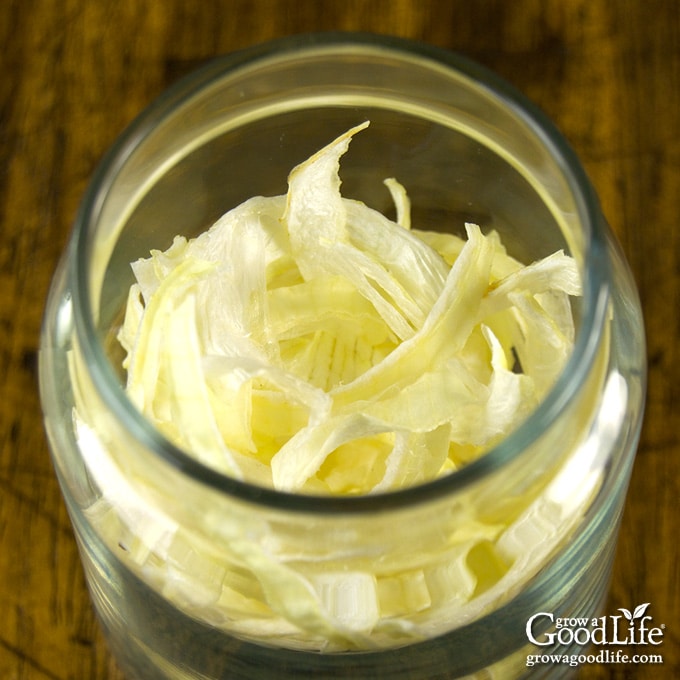
How to Make Dried Minced Onions and Onion Powder
Dehydrated onion pieces can be stored as is, or broken down further into minced onions and onion powder with a food processor, high quality blender, spice grinder, or coffee grinder.
To make minced onions and onion powder, place the dried onion pieces into the bowl of a grinder and pulse until you have a mixture of flakes and powder.
Use a fine mesh strainer over a plate to filter out the smaller pieces from onion powder. Store minced onions and onion powder in separate jars. Label, date, and store in a cool area away from direct light.

How to Use Dehydrated Onions
Use the following replacements for dried onion flakes, minced onions, and onion powder as a guideline to replace fresh onions in your favorite recipes. The flavor will vary depending on the onions used. Also, the flavor of dehydrated onions diminishes over time, so you may need to use more in your recipes if yours is over a year old.
Use dried onion flakes as a substitute for fresh onions in liquid-based recipes such as casseroles, chili, sauces, soup, and stews. The dried onions absorb moisture and reconstitutes as the dish cooks.
- Small Onion (1/3 cup chopped): Substitute 1 tablespoon dried onion flakes.
- Medium Onion (1 cup chopped): Substitute 3 tablespoons dried onion flakes.
- Large Onion (1 1/2 cups chopped): Substitute 4.5 tablespoons dried onion flakes.
Rehydrate minced onions as a replacement for fresh chopped onions in recipes where the dried onion may not have enough liquid to soften.
Substitute rehydrated minced onions for fresh in burgers, meatloaf, and meatballs. Use reconstituted minced onions in recipes that call for chopped raw onions, such as chicken sautés, salads, and dips.
To reconstitute dried minced onions before using, soak 1 part dried minced onions in 2 parts warm water until soft, about 20 minutes. Then proceed with your recipe.
- Small Onion (1/3 cup chopped): Substitute 2 tablespoons dried minced onions.
- Medium Onion (1 cup chopped): Substitute 6 tablespoons dried minced onions.
- Large Onion (1 1/2 cups chopped): Substitute 8 tablespoons dried minced onions.
Onion powder dissolves in liquid and adds a light toasted onion flavor. Use onion powder in dips, salad dressings, or sprinkle on eggs, popcorn, fries, and any dish you want an extra punch of onion flavor.
- Small Onion (1/3 cup chopped): Substitute 1 teaspoon onion powder.
- Medium Onion (1 cup chopped): Substitute 1 tablespoon onion powder.
- Large Onion (1 1/2 cups chopped): Substitute 1.5 tablespoons onion powder.
Dehydrated Onions, Dried Minced Onions, and Onion Powder
Ingredients
- Onions
Instructions
To dry the onions:
- Prepare your onions by removing the skins, trimming the ends, and slicing into even sized pieces.
- Separate the onion segments and spread them out evenly on your dehydrator trays in a single layer.
- Set the temperature of the dehydrator to 125˚F and dry for 3-9 hours. The timing will depend on the size of your onion pieces and moisture content. The dehydrated onions should be crisp and snap when your break them.
- Let the dried onion pieces cool, crush into onion flakes, and package into airtight glass containers or process further into dried onion flakes and onion powder.
To make minced dried onions and onion powder:
- Place the dried onion flakes into the bowl of a spice grinder and pulse until you have a mixture of flakes and powder.
- Use a fine mesh strainer over parchment paper to filter out the onion flakes from the onion powder.
To store the dehydrated onions:
- Store the dehydrated onion flakes, minced onions, and onion powder in separate jars. Label, date, and store in a cool area away from direct light.
- Check the jars in a few days to be sure there isn't any moisture accumulating on the glass. If you find moisture, dehydrate again and repackage into fresh jars.
Nutrition
You May Also Like:
Good planning is key to a successful vegetable garden
Whether you are new to growing your own food or have been growing a vegetable garden for years, you will benefit from some planning each year. You will find everything you need to organize and plan your vegetable garden in my PDF eBook, Grow a Good Life Guide to Planning Your Vegetable Garden.
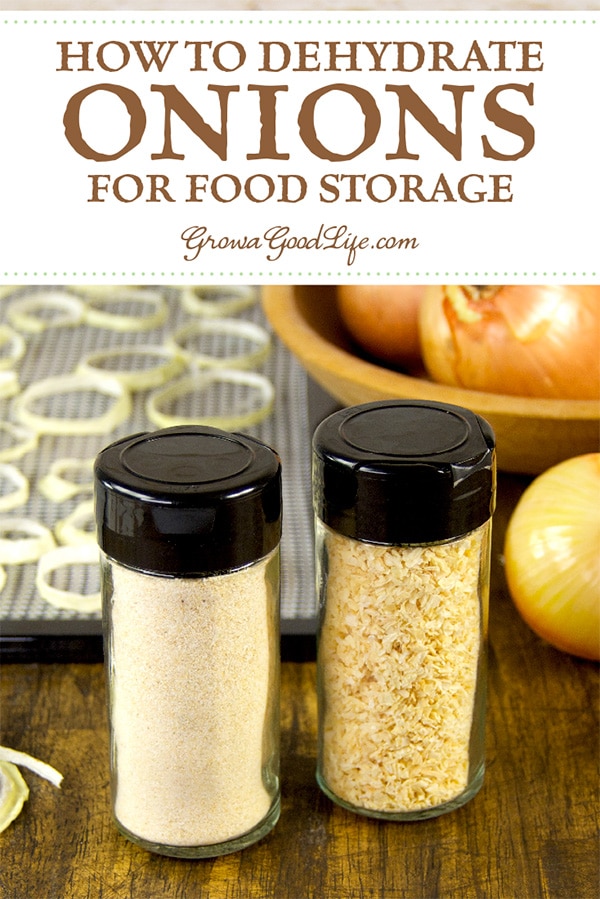



Can I use store bought onions? My garden space is small and I don’t have room for growing onions but would like to dehydrate some for when I can’t make it to the store.
Yes, store bought onions work well.
What can I use to keep the onion powder from clumping?
Gail, Add some uncooked white rice to the container of onion powder. The rice will absorb the moisture.
Ok so I have a dehydrator and have tried multiple times to dry these onions; they never feel DRY; they always feel like onion leather.. they’re less than a 1/4” each piece and spread out over 7 trays, not overlapping. I have tried it on 135* for 2-4 hours, then again for another couple hours; I tried 145* for 2.5 hours; most recently I tried 125* for 3.5 hours and this was all with the same single batch. They STILL do not feel dry. What’s up? Why aren’t they drying??? It’s driving my CRAZY. Is my dehydrator junk??
I have a new Magic Mill 7 tray dehydrator.
A big goal of mine is onion powder and flakes because I make a lot of souls and stews. Help! 🙂
Jenn, Thick slices of onions can dry leathery. Small pieces will snap easily, while the larger pieces may be very leathery but feel dry to the touch. Try storing them in a glass jar and check for moisture each day.
Ive been using an inexpensuve presto dehydrator. It takes at minimum 9 hours for any vegetable or fruit I’ve drived, onions, peppers, apples or blueberries. You can’t go by anyone’s directions. And I’m in dry southern Arizona.
Renie, True. The drying time will vary depending on many factors from the moisture in the fruit or vegetable or the type of dehydrator. If the pieces snap when you bend them and have a dry paper like texture they are done.
I do mine at 200 degrees in the oven or my air fryer. Oven takes about 4 hours while the air fryer only takes 1.5 hours but doesn’t hold much.
is there a way to dehydrate onions if you don’t have a dehydrater
Lisa, You could dehydrate onions using your oven. You’ll need to keep watch over it so the onions don’t burn, and it smells up the house. To dry onions in an oven, spread the slices on a parchment lined baking sheet and dry in a preheated, 150-200˚F (67-93˚C) oven for 1-2 hours until the pieces snap when you break it.
I’m new to dehydrating and wanted to know if you can dehydrate onions that have not been cured? Several of our onions bolted and thought dehydrating would be a great option.
Julia, Yes you can dehydrate freshly harvest onions.
Is it okay to dry can in mason jars, the dehydrated onions? Or are onions one of those vegys that have a high oil content?
Jamie, By “dry can” do you mean oven canning? If so, oven canning is not a safe canning process. You can find more info here: https://extension.psu.edu/canners-and-canning-methods-that-are-not-recommended